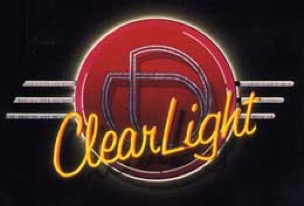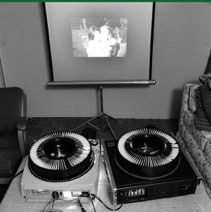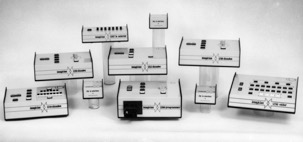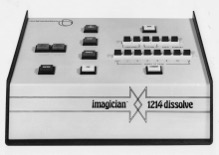A view of Lake Pend Oreille from the mountainside northwest of Sandpoint, and just west of the Airport. My home is just below this viewpoint.
Clear Light History 1
My First Job
Background
While at Park Street Church during my M.I.T. days (or was that "daze?"), I got involved with some guys from the Grad Group that were interested in a new form of evangelism: using rock music and slide projectors to present the Gospel of Jesus Christ to the younger generations. Since I was a "technical guru" they asked if I could build them some "dissolve" units. What, I said, is a dissolve unit? They explained that it allowed you to present a series of slide images with fade-out/fade-in between, rather than just a black out between - the normal thing you see with a single slide projector.

The Clear Light Logo in Neon, displayed at our trade show booth starting in 1978 during the introduction of the Star3 System.

A typical 2-projector with dissolve (not shown) setup
Early Experiments
Knowing a little about slide projectors (I owned one, did all my photograph work with slide film to keep costs low, and to allow me to show my work via a projector), I started researching power control for the lamps, and relay control for the advance/reverse mechanism. All this, right in my MIT graduate residence! It was my background at home during UR undergraduate and high school that came back into active use now, as I put together 7 metal boxes with perforated boards and terminals with parts and wires soldered in place. The metal boxes had buttons and a rotary knob. The dissolve units worked fairly well, but several problems became evident.
One problem was that the power control devices from one dissolve unit would 'latch onto' a pulse from another unit when it’s power control device fired. This would cause the lamps to flicker and not follow their designed fade in/out course. It took some time to figure out how to suppress this.
Another problem was that the relays would sometimes stick, and the projector would merrily just keep advancing. Ultimately, I went through a number of designs to overcome this issue, ultimately - several years later - ending up with optically-coupled SCR’s to solve the problem, along with a number of other tricks.
Decisions, Decisions!
I was looking for an engineering job once I completed my studies at MIT, and I was especially interested in transportation systems. However, I was also very interested in doing something related to my faith. When I was approached by Don Andreson and David Bliss - the founders of Clear Light - about joining them in starting Clear Light, I decided to take that path. From an engineering point of view, it gave me total freedom to invent, develop, and create, and the result was quite a wide range of technologies and products shipped over 16 years, as you will see.

A brief Technology History
Manual Analog Systems: Rotary Knobs vs. Sliders
As we described above, we started out with perforated PC board material with solder terminals and hand-wired parts. My favorite story about this first generation was my instructions for when the relays would get stuck: "just bang it on the table" I would say (in the darkness out there somewhere in the audience, standing behind the projectors) - "And back up the projector to the correct slide." We used these units for early shows on screens made of sewn-together bedsheets!
Later, we sold off these units. I got a call one day from a physics teacher, asking what he should do about a stuck relay, and I gave him my stock answer. A few days later, I got another call: he followed my instructions, and got a lot of smoke, and failure of the unit. Well, I told him to do it, so I offered to fix it. His response was not expected. "Why don’t I just replace all the blackened parts, and see if it works?" he asked. That sounded like a crazy idea, but what the heck. He called back a few days later to tell me that it was now working! Who would have guessed?
The next generation was built in little leather briefcases designed and built to our specifications, along with an aluminum panel with holes professionally machined, and lettering silkscreened. Rather than a rotating control, we had slider controls, like those used in sound control boards, and we could cable 3 units together to be remotely controlled by a single unit with 3 sliders. One person could control a 6-projector show all by themselves - no longer requiring 3 people! Ah, the POWER! It felt like flying a 747! When these units were finally ready, our show, Cry3, was in full swing, and I got to be the first one to run the show all by myself! What a hoot!



Lessons Learned
I learned a very important lesson building these units. I got the first one working, then put together the other 9. None of the other 9 worked. I had to "adjust" each unit with slightly different resistor values to get them to work. This is when I discovered the idea of "design for parts variations within their spec range" or also known as design for manufacturing. A very important lesson that proved valuable many times over!
Paper Tape Digital/Analog Systems
The next development was a tone-based and paper-tape based system, with a binary command language. We used 5 bits for the command, and 3 bits for the "screen areas" for up to 6 projectors. We also had the ability to use a second 8-bits to control an additional 16 projectors, but I do not think we ever used that capability, as our program at the time, Cry 3, was a 6-projector show. This was the Imagician 1200 System, and included dissolve units, programmers, tape playback units, power controls, auxiliary control units, and of course a paper tape punch. The 1214 Dissolve, however, had a built-in multi-tone encoder/decoder, so it was a stand-along unit that could run off a cassette tape recorder, with one control channel and one audio channel.
The first incarnation of this unit was built in white metal breadboxes. Inside, we had actual printed circuit boards, but they were screwed down onto wood blocks! It took us some time to perfect this system so it was reliable. Of course, punching the paper tape was initially by hand punch. The final units had cabinets of my design, professionally bent and punched, and professionally silkscreened. They were a beautiful blue color!

The Imagician 1200 System brochure photo from around 1973
My First Airplane Flight: Technical Service in Ft. Lauderdale!
Yes, it is hard to believe, but up to this point in my life, I had never been on a commercial airliner! One of our customers who bought a 1200 System was doing a six-projector show on the Ft. Lauderdale beach after sunset. They called and told us that it was not working properly, so I was sent, along with an oscilloscope and toolbox, down to Ft. Lauderdale to fix the problem.
Wow! What a beach! I got to swim in the warm Atlantic ocean - a first (I grew up near the COLD Atlantic ocean!) When late afternoon arrived, and they started setting up, the first thing I noticed was that they had added spoolers for the paper tape on either side of the programmer. WHAT? What was happening was the motor in the reader would step forward to read the next line of programming, and the tension on the tape from having to turn the metal spool that the tape was wound around caused a delay just long enough that the tape was between commands - not moved far enough to the next command. So, the circuitry made the decision that this was a section of unpunched tape, and kept stepping until it found a command. This could take about an inch down the tape - essentially skipping over a dozen commands. So we took the tape off the spools, and fixed that problem.
The next problem occurred during the show: The wind was blowing, and I noticed that the cue track was beginning to be audible on the speakers. This indicated to me that the wind was blowing the tape askew, off the tape head essentially. Next, I noticed a "beep" and no action from the 1200 Programmer. I immediately told the operator that we had just "missed a cue" because the tape was being blown off the head. His response was "no, it looks OK to me…" After another 30 seconds, it became clear that I was right. After that, they were careful to shield the 4-track tape deck from the wind! There was no issue with our equipment, but I did get to fly to Ft. Lauderdale, and I would never in a million years been able to diagnose their problem over the phone!

Next Page
Copyright © 2017 Anderson Creations. All Rights Reserved.


